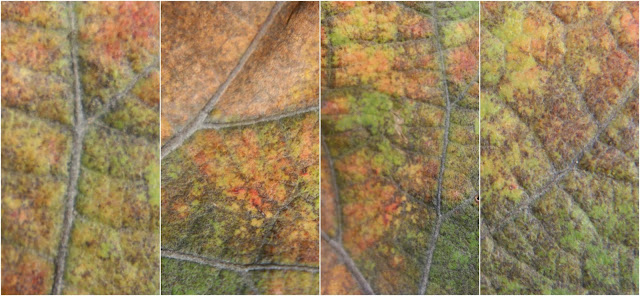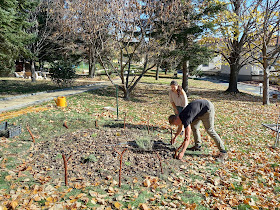Elaeagnus angustfolia - Oleaster, Russian Olive
Uses: Thorny habit makes this plant a great choice for hedges and tolerance to maritime exposure means it's a good plant to consider in coastal regions. The flowers are attractive to bees and other beneficial organisms so may be used as a companion plant. We have used this plant as an understory shrub on a south-facing edge in our forest garden and to take advantage of its drought tolerance, in a dry bed on the outside of the property. In our experience, it is the most drought tolerant of the three species. Classified by USDA as being a high nitrogen fixer.
Elaeagnus x ebbingei - Ebbinge's silverberry
 |
| E. x ebbinge in autumn. In severe winters there may be a degree of leaf loss |
 |
| The fruit of Elaeagnus x ebbinge |
Uses: The tender and soft shoots make excellent biomass and are trimmed and applied as mulch under the productive plants in the forest garden. The dense form means you can harvest a good quantity from pruning. Flowers in the autumn provide late nectar/pollen to pollinators. Fruits are attractive red berries produced in the spring and are very pleasant when fully ripe. High ornamental value, and evergreen, which is useful when creating a privacy screen. Can be used in hedging for this purpose. The dense, shrub-like form provides nesting habitat for birds. Makes an excellent stand-alone ornamental.
Elaeagnus umbellata - Autumn Olive
Overview: A large deciduous shrub growing 4.5m high and 4.5m wide, hardy to zone 3. It
tolerates part shade and is very drought tolerant. Branches are often thorny while leaves are bright green, silvery beneath. Yellowish white, fragrant flowers, are produced in May-June attracting many beneficial organisms. Round, silvery brown (ripening red) fruits appear in Sep-Oct, and it's often a battle between us and the birds as to who gets them first. Although quite fiddly to eat, they are delicious when fully ripe and are sometimes cultivated exclusively for their edible fruit. There are many named cultivars. Plants can fruit in 6 yrs from seed. Like Elaeagnus angustifolia, this species is considered weedy in the U.S. The species is classified by USDA as being a MEDIUM nitrogen fixer
Uses: The plant is used as a nurse tree, when planted with fruit trees it is reported to increase the overall yield of the orchard by 10%. It's a great hedging plant and is also fairly wind tolerant. A candidate for coastal regions as can tolerate maritime exposure. The fruit of E. umbellata is probably my favourite of all three plants and seems to reliably fruit prolifically. As the birds adore the berries, there is a significant increase in numbers to the garden when the berries are ripe.
 |
| Reliable yields from E. umbellata |
Regenerative Landscape Design - Online Interactive Course
Want to learn how to design, build and manage regenerative landscapes? Join us for our Regenerative Landscape Design - Online Interactive Course from May 1st to Sep 13th, 2023.
We're super excited about running the course and look forward to providing you with the confidence, inspiration, and opportunity to design, build and manage regenerative landscapes, gardens, and farms that produce food and other resources for humans while enhancing biodiversity.

Regenerative Landscape Design Online Course
You can find out all about the course here and right now we have a 20% discount on the full enrollment fees. Just use the promo code RLD2023 in the section of the registration form to receive your discount.
We are looking forward to providing you with this unique online learning experience - as far as we know, the very first of its kind. If you are thinking of reasons why you should do this course and whether this course is suitable for you, take a look here where we lay it all out. Looking forward to it!
We're super excited about running the course and look forward to providing you with the confidence, inspiration, and opportunity to design, build and manage regenerative landscapes, gardens, and farms that produce food and other resources for humans while enhancing biodiversity.
 |
| Regenerative Landscape Design Online Course |
You can find out all about the course here and right now we have a 20% discount on the full enrollment fees. Just use the promo code RLD2023 in the section of the registration form to receive your discount.
We are looking forward to providing you with this unique online learning experience - as far as we know, the very first of its kind. If you are thinking of reasons why you should do this course and whether this course is suitable for you, take a look here where we lay it all out. Looking forward to it!
--------------------------------------------------------------------------------------------------------------------------
Support Our Project
If you appreciate the work we are doing you can show your support in several ways.
- Make a purchase of plants or seeds from our Bionursery or Online Store
- Consider joining us for one of our Courses or Online Courses
- Comment, like, and share our content on social media.
- Donate directly via PayPal to balkanecologyproject@gmail.com or via FTX Pay
- Make a purchase of plants or seeds from our Bionursery or Online Store
- Consider joining us for one of our Courses or Online Courses
- Comment, like, and share our content on social media.
- Donate directly via PayPal to balkanecologyproject@gmail.com or via FTX Pay



























